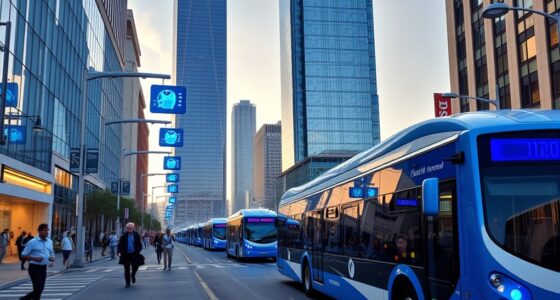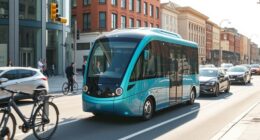Choosing Santiago’s electric bus fleet means you’ll experience cleaner air and better health. Electric buses cut harmful emissions like nitrogen oxides and particulates, reducing smog and improving air quality in the city. This means fewer respiratory and cardiovascular issues for residents and visitors. Plus, cleaner air creates a safer, more livable environment. If you’re curious about how these improvements are achieved and their long-term benefits, keep exploring to discover more.
Key Takeaways
- Electric buses significantly reduce nitrogen oxides and particulate matter emissions, improving Santiago’s air quality.
- Decreased air pollution from electric buses lowers respiratory and cardiovascular health risks for residents.
- The cleaner air enhances urban livability and outdoor activity safety for vulnerable populations.
- Strategic charging infrastructure and renewable energy integration amplify environmental and public health benefits.
- Continued adoption of electric buses fosters a healthier, more sustainable urban environment in Santiago.

Santiago is transforming its public transportation system by introducing an extensive electric bus fleet aimed at reducing emissions and improving air quality. This shift directly benefits public health by decreasing pollutants like nitrogen oxides and particulate matter, which are common culprits behind respiratory and cardiovascular issues. As you navigate the city, you’ll notice cleaner air and less smog, thanks to this environmentally conscious move. The success of this shift relies heavily on the development of robust charging infrastructure, which guarantees that buses can recharge efficiently throughout the day. Strategic placement of charging stations at bus depots and key transit points allows for quick turnaround times, minimizing downtime and keeping buses on schedule.
Advancements in battery technology play a vital role in making electric buses viable for Santiago’s extensive network. Modern batteries offer higher energy density, meaning buses can travel longer distances on a single charge, reducing the need for frequent recharging. This not only improves operational efficiency but also lowers maintenance costs. As you ride one of these electric buses, you’ll likely notice how quiet and smooth the journey is compared to traditional diesel-powered vehicles. The quieter operation reduces noise pollution in the city, contributing further to public health and overall urban livability.
Modern batteries enable longer, quieter, and smoother electric bus rides, reducing noise pollution and enhancing urban livability.
The charging infrastructure is designed to be scalable and adaptive, which is essential as Santiago plans to expand its electric fleet. Fast-charging stations enable buses to quickly replenish their batteries during short stops, making the system more flexible and reducing the risk of delays. Additionally, the integration of renewable energy sources into the grid powering these stations amplifies the environmental benefits, further decreasing the city’s carbon footprint. Battery technology improvements have also increased safety and durability, making sure that the electric buses can withstand the demanding conditions of daily urban transit. Moreover, the use of portable energy solutions can support the charging needs during peak times or in areas with limited grid access.
This modernization effort not only reduces emissions but also fosters a healthier environment for residents and visitors alike. With cleaner air, you’ll experience fewer health issues related to air pollution, and the city’s overall quality of life improves. As Santiago continues to invest in charging infrastructure and cutting-edge battery technology, you can expect even more reliable and sustainable public transportation options in the future. This initiative exemplifies how technological advancements and strategic planning can work together to create a cleaner, healthier, and more sustainable urban environment.
Frequently Asked Questions
How Long Do the Electric Bus Batteries Typically Last?
Electric bus batteries typically last between 8 to 12 years, depending on usage and maintenance. You should monitor battery health regularly to optimize battery longevity. When they do reach the end of their lifespan, replacement costs can be significant, but advances in technology are helping to lower these expenses. Proper care can extend the life of your batteries, saving you money and ensuring reliable performance over many years.
What Is the Cost Difference Between Electric and Diesel Buses?
Think of choosing buses as planting a garden—you’ll face upfront costs but reap lasting benefits. Electric buses typically cost more initially than diesel ones, mainly due to higher upfront costs. However, you save on maintenance, as electric buses have fewer moving parts, and enjoy lower fuel expenses. Over time, these maintenance savings and reduced fuel costs can offset the initial investment, making electric buses a smarter, more sustainable choice.
Are Renewable Energy Sources Used for Charging the Buses?
Yes, renewable energy sources are used for charging the buses. You benefit from renewable integration, which guarantees that the energy sourcing for the electric fleet is environmentally friendly. Santiago’s efforts focus on increasing renewable energy use, reducing reliance on fossil fuels, and lowering emissions. By prioritizing renewable energy, you help improve air quality and support sustainable transportation initiatives that positively impact public health.
How Does the Electric Fleet Impact Santiago’s Overall Carbon Footprint?
You’re on the right track to make a difference. The electric fleet considerably cuts Santiago’s overall carbon footprint by reducing emissions from traditional buses. This shift boosts sustainability impact, helping the city meet climate goals. As you embrace cleaner transportation options, you contribute to lower greenhouse gases, supporting a healthier environment. It’s a win-win situation where your choices drive positive change and help Santiago move towards a greener future.
What Challenges Have Been Faced During Electric Bus Implementation?
You might face infrastructure hurdles like charging station availability and grid capacity when implementing electric buses, which can slow progress. Public acceptance can also be challenging if residents worry about costs or reliability. To overcome these issues, you need clear communication and strategic planning, ensuring infrastructure upgrades happen alongside public outreach. Addressing these challenges head-on helps make the shift smoother and gains community support for cleaner transportation.
Conclusion
By switching to electric buses, you’re not just improving air quality—you’re transforming Santiago into a gust of fresh air in a city choking on pollution. This shift dramatically cuts harmful emissions, protecting public health and making every ride cleaner and safer. Imagine a future where the air is so pure, it feels like you’re inhaling a miracle. Your support for this change helps turn that vision into reality, proving that cleaner air is possible—and within reach.









